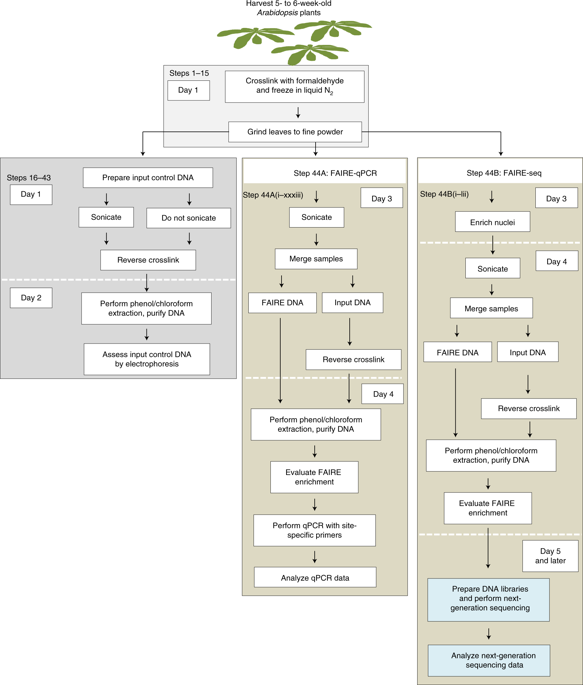当前位置:
X-MOL 学术
›
Nat. Protoc.
›
论文详情
Our official English website, www.x-mol.net, welcomes your
feedback! (Note: you will need to create a separate account there.)
Formaldehyde-assisted isolation of regulatory DNA elements from Arabidopsis leaves.
Nature Protocols ( IF 13.1 ) Pub Date : 2020-02-10 , DOI: 10.1038/s41596-019-0277-9 Stephani Baum 1 , Eva-Maria Reimer-Michalski 1 , Michal R Jaskiewicz 1 , Uwe Conrath 1
Nature Protocols ( IF 13.1 ) Pub Date : 2020-02-10 , DOI: 10.1038/s41596-019-0277-9 Stephani Baum 1 , Eva-Maria Reimer-Michalski 1 , Michal R Jaskiewicz 1 , Uwe Conrath 1
Affiliation

|
Eukaryotic gene transcription is associated with the eviction of nucleosomes and the formation of open chromatin, which enables the recruitment of transcriptional coactivators and other regulatory factors. Open chromatin is thus a hallmark of functional regulatory DNA elements in genomes. In recent years, formaldehyde-assisted isolation of regulatory elements (FAIRE) has proven powerful in identifying open chromatin in the genome of various eukaryotes, particularly yeast, human, and mouse. However, it has proven challenging to adapt the FAIRE protocol for use on plant material, and the few available protocols all have their drawbacks (e.g., applicability only to specific developmental stages). In this Protocol Extension, we describe a reliable FAIRE protocol for mature Arabidopsis (Arabidopsis thaliana) leaves that adapts the original protocol for use on plants. The main differences between this protocol extension and the earlier FAIRE protocol are an increased formaldehyde concentration in the chromatin crosslinking buffer, application of a repeated vacuum to increase crosslinking efficiency, and altered composition of the DNA extraction buffer. The protocol is applicable to leaf chromatin of unstressed and stressed plants and can be completed within 1 week. Here, we also describe downstream analysis using qPCR and next-generation sequencing. However, this Protocol Extension should also be compatible with downstream hybridization to a DNA microarray. In addition, it is likely that only minor adaptations will be necessary to apply this protocol to other Arabidopsis organs or plant species.
中文翻译:

甲醛辅助从拟南芥叶片中分离调节性DNA元素。
真核基因转录与核小体的逐出和开放染色质的形成有关,这使得募集转录共激活因子和其他调节因子成为可能。因此,开放染色质是基因组中功能性调节DNA元件的标志。近年来,已证明甲醛辅助分离的调控元件(FAIRE)在鉴定各种真核生物,尤其是酵母,人和小鼠的基因组中的开放染色质方面很有效。然而,事实证明,将FAIRE规程改编用于植物材料具有挑战性,并且几乎没有可用的规程都有其缺点(例如,仅适用于特定的发育阶段)。在此协议扩展中,我们描述了一种成熟的拟南芥(Arabidopsis thaliana)叶片的可靠FAIRE方案,该方案适用于植物上的原始方案。该协议扩展与较早的FAIRE协议之间的主要区别在于,染色质交联缓冲液中甲醛浓度增加,重复施加真空以提高交联效率以及DNA提取缓冲液的成分发生了变化。该方案适用于未受胁迫和受胁迫植物的叶片染色质,可在1周内完成。在这里,我们还描述了使用qPCR和下一代测序的下游分析。但是,此协议扩展也应与DNA微阵列的下游杂交兼容。此外,
更新日期:2020-02-10
中文翻译:

甲醛辅助从拟南芥叶片中分离调节性DNA元素。
真核基因转录与核小体的逐出和开放染色质的形成有关,这使得募集转录共激活因子和其他调节因子成为可能。因此,开放染色质是基因组中功能性调节DNA元件的标志。近年来,已证明甲醛辅助分离的调控元件(FAIRE)在鉴定各种真核生物,尤其是酵母,人和小鼠的基因组中的开放染色质方面很有效。然而,事实证明,将FAIRE规程改编用于植物材料具有挑战性,并且几乎没有可用的规程都有其缺点(例如,仅适用于特定的发育阶段)。在此协议扩展中,我们描述了一种成熟的拟南芥(Arabidopsis thaliana)叶片的可靠FAIRE方案,该方案适用于植物上的原始方案。该协议扩展与较早的FAIRE协议之间的主要区别在于,染色质交联缓冲液中甲醛浓度增加,重复施加真空以提高交联效率以及DNA提取缓冲液的成分发生了变化。该方案适用于未受胁迫和受胁迫植物的叶片染色质,可在1周内完成。在这里,我们还描述了使用qPCR和下一代测序的下游分析。但是,此协议扩展也应与DNA微阵列的下游杂交兼容。此外,









































 京公网安备 11010802027423号
京公网安备 11010802027423号